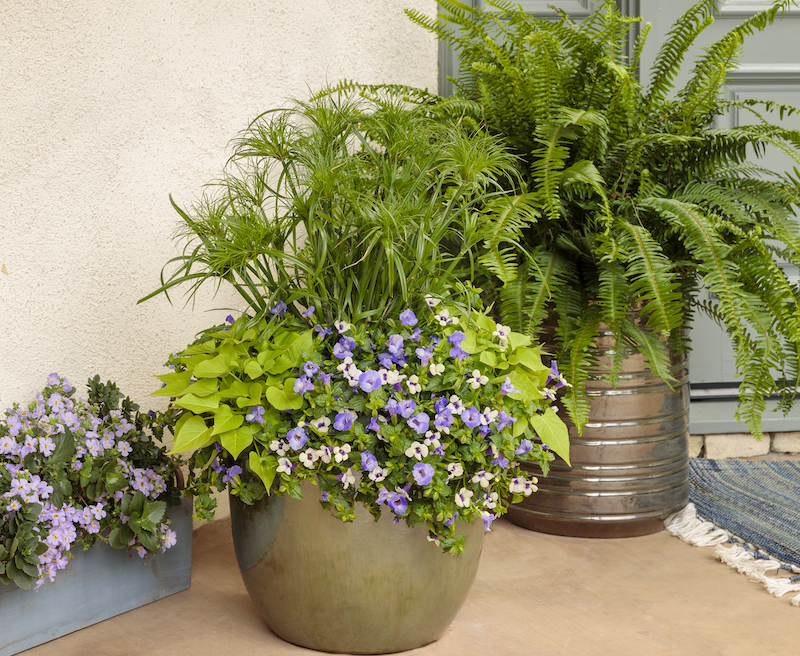One of the most versatile tender perennials is Bacopa. Bacopa is grown as an annual in all of the USDA zones but is actually perennial in zones 9-11 where it makes for a very nice, spreading ground cover in a garden with full sun and consistently moist soil that drains well. Plant bacopa alongside other more formal plants such as clipped, broadleaf evergreen hedges or tropical houseplants that enjoy summers on a patio or deck. The non-stop flowering and trailing growth habit of bacopa make it a natural spiller element in hanging baskets, window boxes, and other planters.

Shrubs To Plant With Bacopa
In the warmer growing zones of 9-11, Bacopa makes for an easy-care ground cover when paired with boxwood, arborvitae, false cypress, or yew hedging. The pretty purple, white, or pink flowers stand out against the deep green foliage of most formal hedging. Bacopa also looks great as a ground cover with more free flowering shrubs such as abelia, dogwood, spirea, shrub roses, and weigela. Any shrub that thrives in moist soil with moderate fertility is a good choice to grow near bacopa.
Perennials To Plant With Bacopa
Bacopa is a solid choice to pair with herbaceous perennials as it will grow equally well in sunny or partly shady locations as long as the soil retains moisture well. Shade-loving woodland plants look great with white flowering bacopa, giving the whole design a calming and sophisticated look. Use foliage plants like hostas, ferns, brunnera, and coral bells, to create a serene green-and-white garden design.
Perennials that enjoy more sun also grow well alongside bacopa. A mix of Siberian iris, obedient plant, Japanese iris, and turtlehead lilies will be the stars of the garden when finished with an edging or ground cover of bacopa in a contrasting or complementary shade.
Annuals To Plant With Bacopa
Bacopa mixes perfectly with many different annuals and will flower well into the fall even through a light frost or two. Plant bacopa at the front of a bedding design with wax begonias, pansies, verbena, snapdragons, polka dot plant, or impatiens. Fertilize the garden bed before bacopa and any other annuals are planted to ensure a long flowering display that requires little maintenance. Mix a slow-release, granular fertilizer into the soil so that the plants will be fed at every watering. Mulch well around the base of the plants to help the soil retain moisture and stay a few degrees cooler during the heat of summer.

Best Companion Plants For Bacopa in Containers
Bacopa is by far best used as a filler and spiller plant in mixed seasonal containers or planted alone. The natural trailing habit of bacopa and the range of flower colors make it a go-to for just about any container, hanging basket, or window box. Adding grasses or reed plants to a container will elevate the design and add texture. Papyrus reed, lime green sweet potato vine, and wishbone flower pair nicely with pink bacopa spilling over the side of the pot. Fertilize this potted arrangement once a month using a diluted liquid seaweed or fish emulsion to help the plants maintain their vibrant color and strong foliage growth.

Plants Not To Grow With Bacopa
The key to keeping bacopa flowering well for the whole season is consistent watering and good drainage. If bacopa is left to dry out too many times, it will not recover fully, shortening its lifespan. Therefore, waterwise plants such as most native grasses, coneflowers, agastache, lavender, and rosemary do not make suitable companions for bacopa. Those plants will not tolerate the regular moisture bacopa craves.
Best Plants To Grow With Bacopa
A white-themed garden is always a winning design that looks lovely during the day and even better near twilight when the white flowers shine. A low-growing combination of shrubs and annuals also makes for the perfect short-term planting solution near a patio or deck. Plant trailing and spreading alyssum, bacopa, sweet potato vine, annual euphorbia, and petunias to fill in and cover the ground near evergreens such as dwarf buckthorn. Throughout the summer, the annuals will fill in and provide non-stop flowers that attract beneficial pollinators and humans alike.
 |
Author Robbin Small - Published 10-03-2023 |
